Infectious diarrheal diseases
Definition- what is infectious diarrheal disease?
An infectious diarrhea is the occurrence of diarrhea that is triggered by a pathogen. One speaks of diarrhea if the stool is too liquid more than three times a day. The infection can be triggered by bacteria, viruses, worms or parasites.
These are mostly transmitted through contaminated food and are often self-limiting, which means that they pass after a few days. Therefore, the pathogens are often not identified because no specific therapy is required.
During the period of diarrhea, it is particularly important to ensure adequate fluid intake, as the body loses a lot of water and electrolytes through diarrhea.

These bacterial pathogens do exist
There are many bacterial pathogens that can lead to an infectious diarrhea. One of the most common pathogens is the Campylobacter bacterium, which can be transmitted from person to person through contact with infected stool. Salmonella, which is often found in contaminated meat or egg products, can also cause diarrhea.
Shigella, Yersinia and cholera are rare these days. In recent years, the EHEC bacteria have become more and more popular as a cause of infectious diarrheal diseases. Clostridium difficile, a specific type of clostridia, can also lead to diarrhea after prolonged use of antibiotics.
Many bacterial pathogens cause diarrhea. However, there are other possible factors that can cause diarrhea. Read more about this at: Causes of diarrhea
These viral pathogens do exist
The two most important viral pathogens that can cause infectious diarrhea are noroviruses and rotaviruses. Due to their resistance to many disinfectants, noroviruses are common in hospitals. They typically lead to diarrhea and vomiting, which will pass within a maximum of 48 hours. This is also known as self-limiting infection. Rotaviruses are highly contagious and lead to diarrhea, especially in small children and infants. They can be transmitted from person to person or through contaminated drinking water.
These parasitic pathogens do exist
Parasites can also cause infectious diarrhea. Probably the most well-known pathogens among the parasites are the amoeba, which lead to amoebic dysentery. This leads to typical raspberry jelly-like diarrhea, which gets this color from a slight blood in the stool. The amoeba are mainly found in tropical areas. The parasites Giardia lamblia (Lamblia) also occur more frequently in warm regions of the world and lead to recurring diarrhea, which is particularly watery.
Read more on this topic at: Giardiasis - diarrhea caused by parasites
These worm diseases lead to diarrhea
The appearance of diarrhea is a common symptom in various worm diseases. These include, for example, various hookworms that tend to be in the small intestine and lead to blood in the stool. These worms enter the human body through the skin. Certain types of thread warmers, which are mainly transmitted through undercooked meat, can also lead to diarrhea, vomiting and muscle pain. After penetrating the body through the skin, the dwarf threadworm initially leads to inflammation of the airways and later to diarrhea and nausea.
Read more on the subject at: Worms in the intestines
Salmonella
Salmonella is one of the best-known bacterial pathogens causing infectious diarrhea. They are transmitted through contaminated food and are often found in meat or egg dishes. Since they cannot be killed by the cold, it is therefore always advisable to heat the food sufficiently. For this purpose, heating should take place at at least 70 ° C for approx. 10 minutes.
The first symptoms can appear a few hours later, depending on the number of pathogens transferred. Pronounced diarrhea occurs, which is usually very watery and can sometimes contain blood. These often occur with severe vomiting. Furthermore, there is sometimes fatigue, headache and a slight fever.
Salmonella can also lead to life-threatening blood poisoning in people who are also taking immunosuppressive medication or who suffer from an immunosuppressive disease. Drug therapy is only recommended for severe disease or immunosuppression, as antibiotics can otherwise delay the excretion of Salmonella from the body.
For more information, see: Salmonella
Campylobacter
Campylobacter is the most common pathogen causing infectious diarrhea in Germany. It is mainly transmitted through contaminated food, such as poultry or dairy products, and is highly contagious. Approx. 2-5 days after transmission, non-specific symptoms that are similar to flu appear initially. Later it comes to severe, watery and often bloody diarrhea. They often come along with a fever and severe pain in the lower abdomen.
Since the symptoms usually go away on their own after a few days, it is important to ensure that there is an adequate supply of fluids and electrolytes. In particularly severe cases, antibiotic treatment should be considered if necessary.
Shigella
The Shigella are usually transmitted through contaminated water or food. In the latter case, vegetables that are not adequately cleaned are typical. After the transmission, diarrhea usually occurs within 3 days. These are often very watery and come along with severe exhaustion. Occasionally there is also a stronger expression, which is accompanied by blood in the stool, fever and pain when defecating. Shigella dysentery should always be treated with antibiotics such as azithromycin or ceftriaxone due to the high risk of infection.
cholera
The cholera bacterium, which rarely occurs in Europe, is mostly transmitted via contaminated food or contaminated drinking water. After an infection has expired, it can be excreted in the stool for several weeks, which in turn carries a high risk of infection. The diarrhea caused can vary in severity and is occasionally accompanied by vomiting.
Typically, however, a fever does not occur with a cholera infection. Adequate fluid intake is extremely important; for more severe courses, ciprofloxacin should be given, for example. Since around 1% of all cholera infections are fatal, vaccination is recommended when traveling to risk areas.
Read more on the topic: cholera
pathogenic E. Coli (EHEC / EPEC)
E. coli is a naturally occurring bacterium in the gut. However, there are pathogenic, so-called pathogenic subtypes, such as EHEC or EPEC, that can lead to diarrhea. EHEC occurs more frequently in industrialized countries and leads to watery diarrhea, some of which are bloody, after 10 days at the latest. EPEC, on the other hand, occurs mainly in developing countries and mainly infects children. The result is rather mushy diarrhea, which is difficult to treat due to the many resistances of the bacteria.
Further information can be found at: E. coli
Yersinia
The Yersinia bacteria can be transmitted indirectly through animal foods such as dairy or meat products. After approx.For 3 to 10 days they lead to diarrhea that can last for weeks and is accompanied by abdominal pain.
It also develops what is known as pseudoappendicitis, in which there are signs of inflammation of the appendix, but the actual inflammation is not present. If the disease progresses significantly, this infectious diarrheal disease should be treated with antibiotics such as ciprofloxacin.
Whipple's disease
Whipple's disease is a disease caused by a bacterium. It is rare and affects mostly middle-aged men. The intestinal infestation of the bacteria leads to diarrhea, abdominal pain and impaired absorption of nutrients from food.
Joint inflammation, fever and enlarged lymph nodes can also occur. Occasionally the bacteria also infect the heart or various nerve tracts. Whipple's disease must be treated with antibiotics (first ceftriaxone and later cotrimoxazole), otherwise this disease is fatal.
Read more on the topic: Whipple's disease
Clostridium difficile
The bacterium Clostridium difficile is particularly widespread in hospitals and among children. Diarrhea usually only occurs when the intestines are irritated from prolonged use of antibiotics. This is the case, for example, after pneumonia. The clostridia difficile use the damaged intestinal wall and lead to severe abdominal pain and foul-smelling diarrhea.
Often there is also a high fever. Since this infectious diarrheal disease can lead to various complications, such as an intestinal obstruction (ileus) or blood poisoning (sepsis), rapid treatment is important. The focus here is on antibiotics and consistent compliance with hygiene.
Read more about this: Clostridium difficile
Norovirus
The noroviruses are common in hospitals and are transmitted from person to person. They are highly contagious and cause symptoms to appear within a few hours. These include gushing vomiting and severe diarrhea, which are particularly watery. The symptoms typically subside within 12 to a maximum of 48 hours after they occur.
Therefore, the treatment is only symptomatic and consists of a sufficient supply of fluids and electrolytes. Since there is currently no vaccination, the most effective prevention against this infection is compliance with hygiene rules.
Read more on the topic: Norovirus- how dangerous is it?
Rotavirus
The rotavirus occurs mainly in developing countries and mainly affects young children and the elderly. Since the virus is very contagious and leads to symptoms after just a few hours, the disease often spreads quickly. This includes suddenly onset of watery diarrhea with vomiting, fever and pain in the abdomen.
Furthermore, the throat and windpipe are affected in half of all infected. Treatment includes adequate fluid and electrolyte intake. Since infants in particular do not yet have a sufficiently developed immune system, oral vaccination against the rotavirus is recommended for them.
You might also be interested in this topic: Vaccination against the rotavirus
Amoeba
The parasitic pathogens amoeba lead to the disease amoebic dysentery. They are mainly transmitted through contaminated drinking water and do not lead to symptoms in almost 90% of infections. If symptoms occur, they can be divided into two forms. If the amoeba infects the intestine, typical raspberry jelly-like diarrhea occurs, which is often associated with painful bowel movements. Alternatively, if the liver is affected, the amoeba can lead to abscesses, a collection of pus. The treatment of amoebic dysentery consists of the antibiotics metronidazole and paromomycin.
For more information, see: Amoeba
Lamblia
The parasites Giardia lamblia (lamblia) occur mainly in tropical and subtropical areas and are transmitted via contaminated drinking water. They lead to severe abdominal pain and frothy, large amounts of diarrhea that contain a lot of fat. Nausea, gas, fatigue and vomiting can also occur. Usually the symptoms subside after 2-3 weeks and there are seldom long-lasting symptoms. Therapy consists of the administration of metronidazole.
You can find more on this topic under: Giardiasis - diarrhea caused by parasites


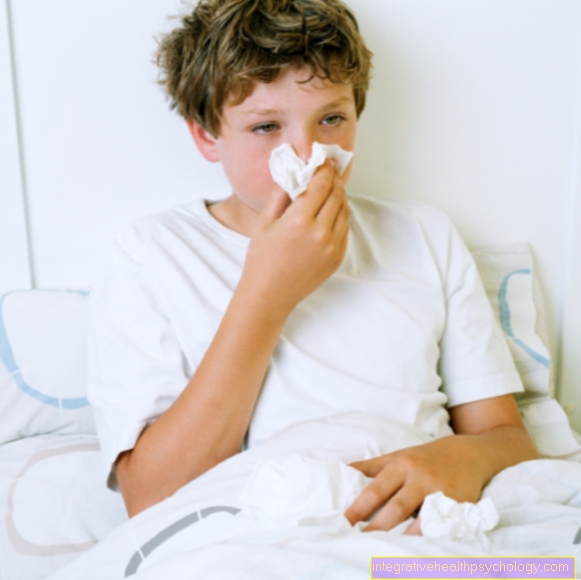


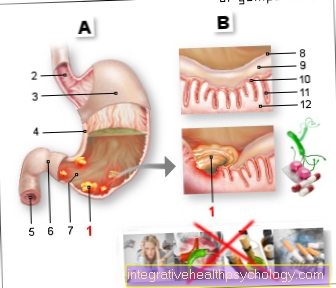


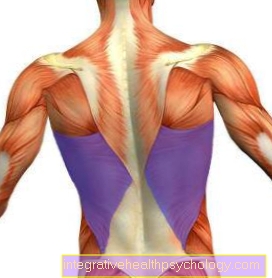






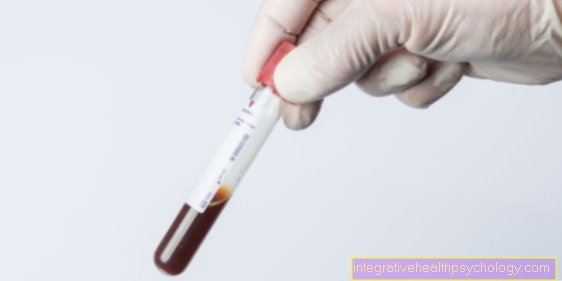








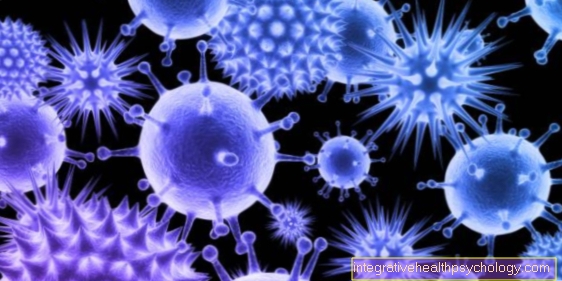



.jpg)
.jpg)